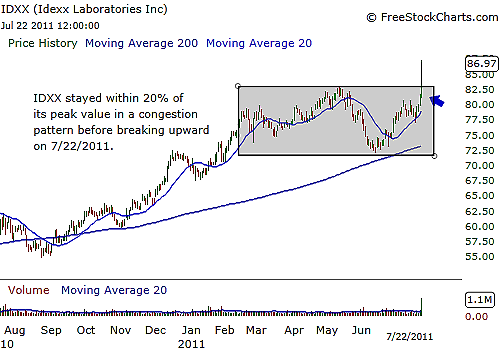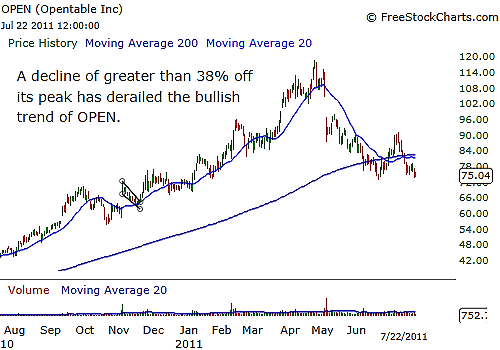
HOT TOPICS LIST
- MACD
- Fibonacci
- RSI
- Gann
- ADXR
- Stochastics
- Volume
- Triangles
- Futures
- Cycles
- Volatility
- ZIGZAG
- MESA
- Retracement
- Aroon
INDICATORS LIST
LIST OF TOPICS
PRINT THIS ARTICLE
by Billy Williams
Understanding the difference between price consolidation and a price correction can keep you in a winning trade and out of a losing one.
Position: Hold
Billy Williams
Billy Williams has been trading the markets for 27 years, specializing in momentum trading with stocks and options.
PRINT THIS ARTICLE
TECHNICAL ANALYSIS
Price Consolidation Versus Price Correction
07/26/11 08:57:37 AMby Billy Williams
Understanding the difference between price consolidation and a price correction can keep you in a winning trade and out of a losing one.
Position: Hold
| For novice traders and even experienced traders, there can be a feeling of "Okay, what do I do next?" after entering a strong move in a stock. Aside from the normal trade management sequences that you should know and plan for when entering a trade, there is a nagging feeling of not wanting to get caught flat-footed if and when the market suddenly turns against your position. This is normal, especially if you've taken an unexpected loss in the same scenario, because apart from the capital you lose, you also take a serious blow to your confidence. It's as if after a car accident, when you're getting back out on the road, you find yourself acutely aware of the drivers around you and feel more threatened that you did before the accident. In trading the market, you can find yourself in an endless loop of either selling too soon and missing out on a larger potential gain or staying in a position too long and end up watching a position where a large gain vanishes before your eyes. |

|
| FIGURE 1: IDXX. IDXX was on a steady trend until it went through a normal phase of price consolidation until it broke higher on July 22, 2011. |
| Graphic provided by: www.freestockcharts.com. |
| |
| Fortunately, this type of fear in trading is normal and can be helped through a combination of training and coming to understand a few key fundamentals such as identifying whether the stock and/or market is experiencing a period of price consolidation (Figure 1) or a price correction (Figure 2). This can help you realize when it is in your best interest to stay in a position or whether it's best to cash in your chips and sit aside, waiting for the next opportunity. As a stock's price goes back and forth during a steady phase of buying and selling, the stock will rise or fall within the context of the current market being either bullish or bearish. When price enters a period of consolidation, meaning a period of price contraction, its price reaches its peak and then backs away within 15% to 20% of its total value. If a stock reaches a high of $100 a share, then it will typically retreat no lower than $80 to $85 a share if enough buyers continue to hold long positions and the stock shows high resiliency and relative strength compared to other stocks in the market, the higher the better for bulls. For bears, price may fall to $100 a share and retreat to $80 to $85 a share but exhibit poor resiliency and declining relative strength comparatively to other stocks in the market. |

|
| FIGURE 2: OPEN. OPEN was steadily climbing higher, making a steady series of higher highs and higher lows until its trend broke down and retraced more than 38%, signaling a price correction and an exit from the stock itself. |
| Graphic provided by: www.freestockcharts.com. |
| |
| It is during these cycles that it is typically accepted to sit tight in a position in order to maximize your profits in a trade, comforted by the knowledge that this type of price behavior is healthy and normal but still use risk control to avoid the unexpected. However, price corrections are another matter entirely and send off huge red flags, signaling an exit from the market, as the trend is likely to halt or reverse. In stocks, price corrections cause price to exceed 38% of their value and can result in tectonic shifts in the direction of that stock's price action, confirming that you should exit or hedge your position accordingly. |
| In the overall market, any retracement of the Standard & Poor's 500 greater than 15% to 20% from its peak is a signal for total liquidation of any position currently in sync with its price direction, and a defensive posture must be adopted immediately. The distinctions between these two types of price action can help you determine whether to sit tight in a winning position in the knowledge that price is likely to continue to be favorable to you over time unless the market signals something different, such as a price correction in the stock or the market itself. |
| One more point: by picking the strongest stocks that are favorable to the current trend in place within the major indexes, like the S&P 500, if you were to experience a correction in the index itself, then these types of stocks hold up better in the current market environment, which should give you additional time to make any necessary adjustments to your portfolio as you see fit. |
Billy Williams has been trading the markets for 27 years, specializing in momentum trading with stocks and options.
| Company: | StockOptionSystem.com |
| E-mail address: | stockoptionsystem.com@gmail.com |
Traders' Resource Links | |
| StockOptionSystem.com has not added any product or service information to TRADERS' RESOURCE. | |
Click here for more information about our publications!
Comments

|

Request Information From Our Sponsors
- StockCharts.com, Inc.
- Candle Patterns
- Candlestick Charting Explained
- Intermarket Technical Analysis
- John Murphy on Chart Analysis
- John Murphy's Chart Pattern Recognition
- John Murphy's Market Message
- MurphyExplainsMarketAnalysis-Intermarket Analysis
- MurphyExplainsMarketAnalysis-Visual Analysis
- StockCharts.com
- Technical Analysis of the Financial Markets
- The Visual Investor
- VectorVest, Inc.
- Executive Premier Workshop
- One-Day Options Course
- OptionsPro
- Retirement Income Workshop
- Sure-Fire Trading Systems (VectorVest, Inc.)
- Trading as a Business Workshop
- VectorVest 7 EOD
- VectorVest 7 RealTime/IntraDay
- VectorVest AutoTester
- VectorVest Educational Services
- VectorVest OnLine
- VectorVest Options Analyzer
- VectorVest ProGraphics v6.0
- VectorVest ProTrader 7
- VectorVest RealTime Derby Tool
- VectorVest Simulator
- VectorVest Variator
- VectorVest Watchdog
